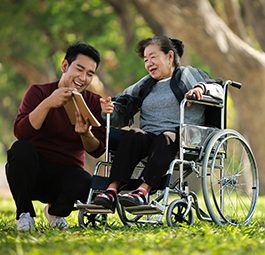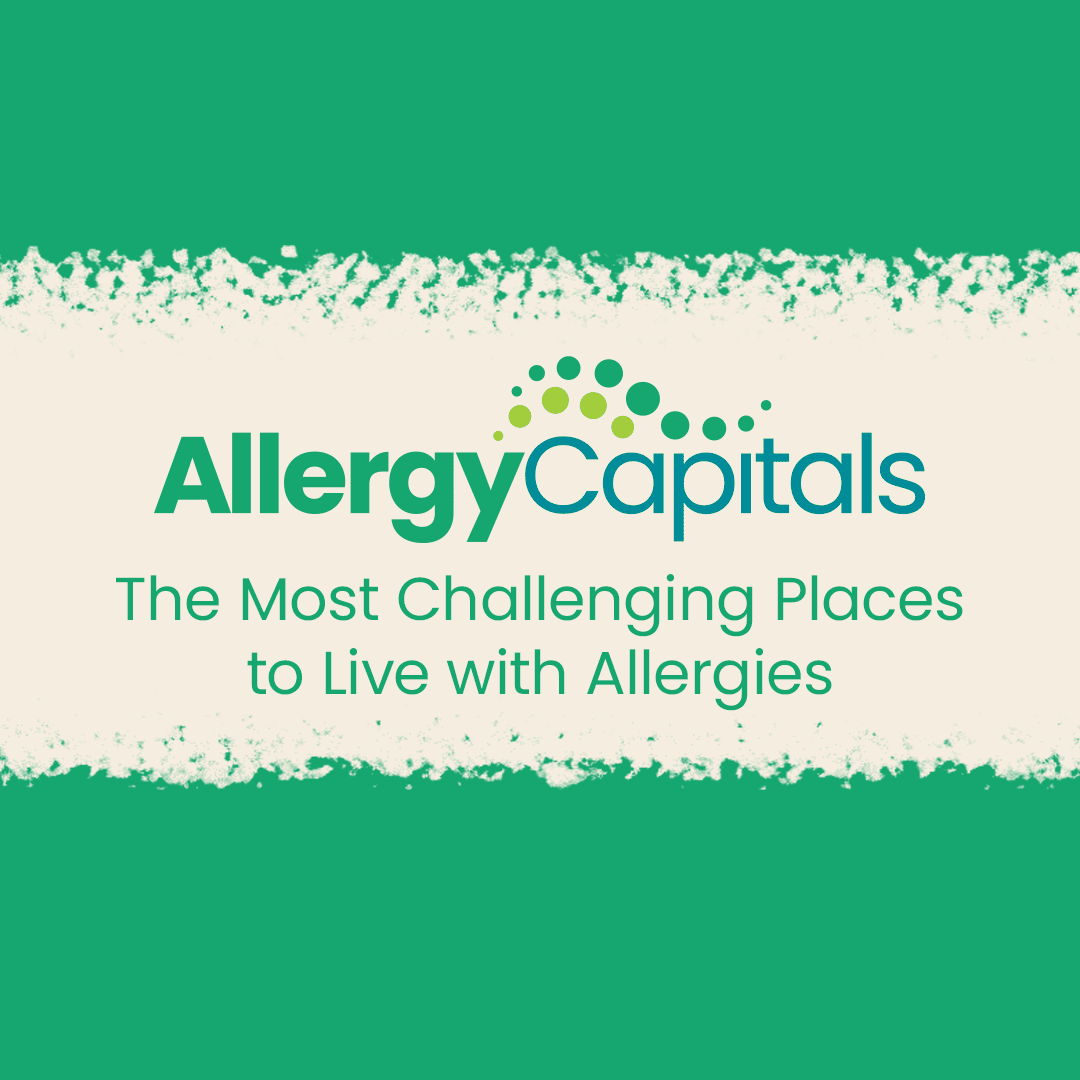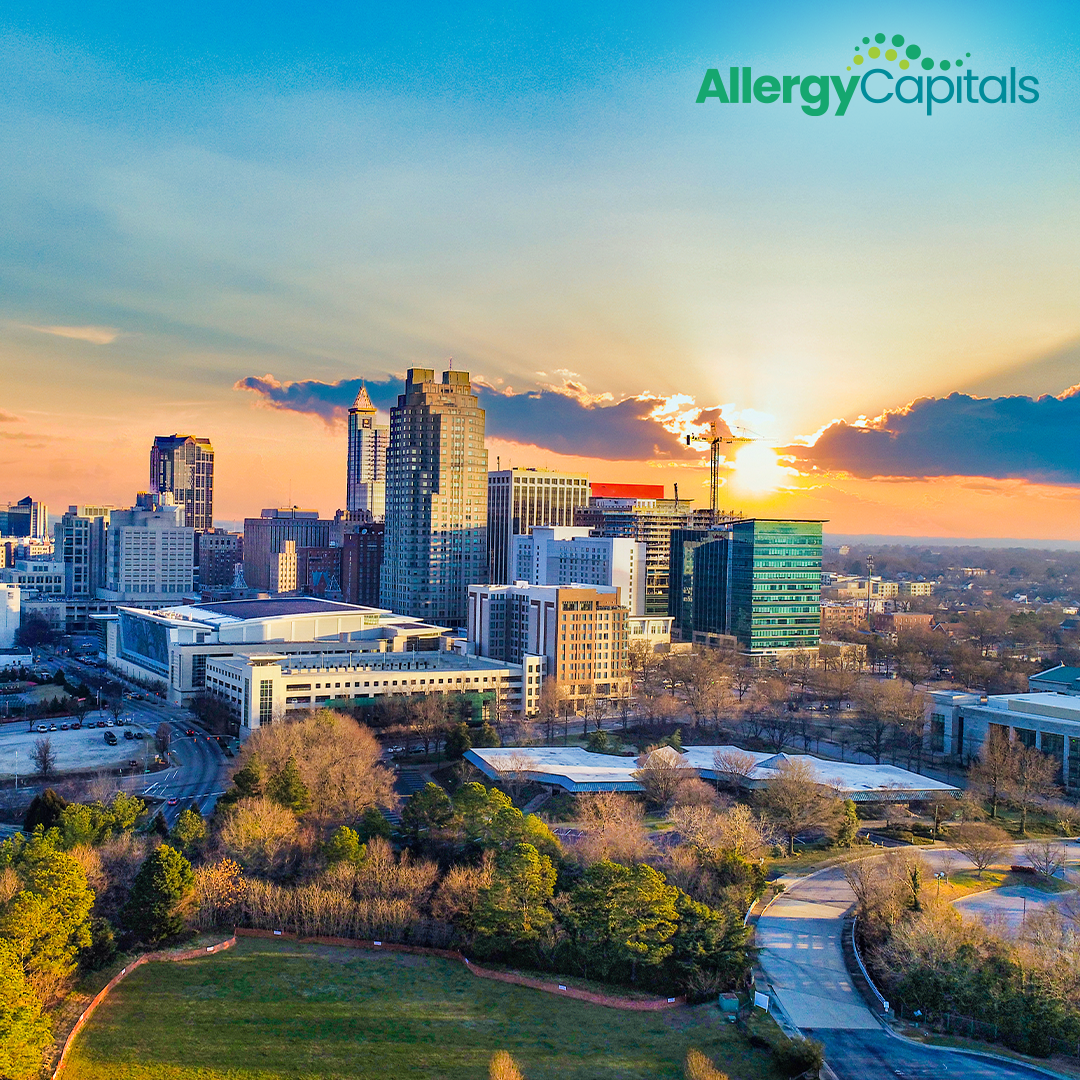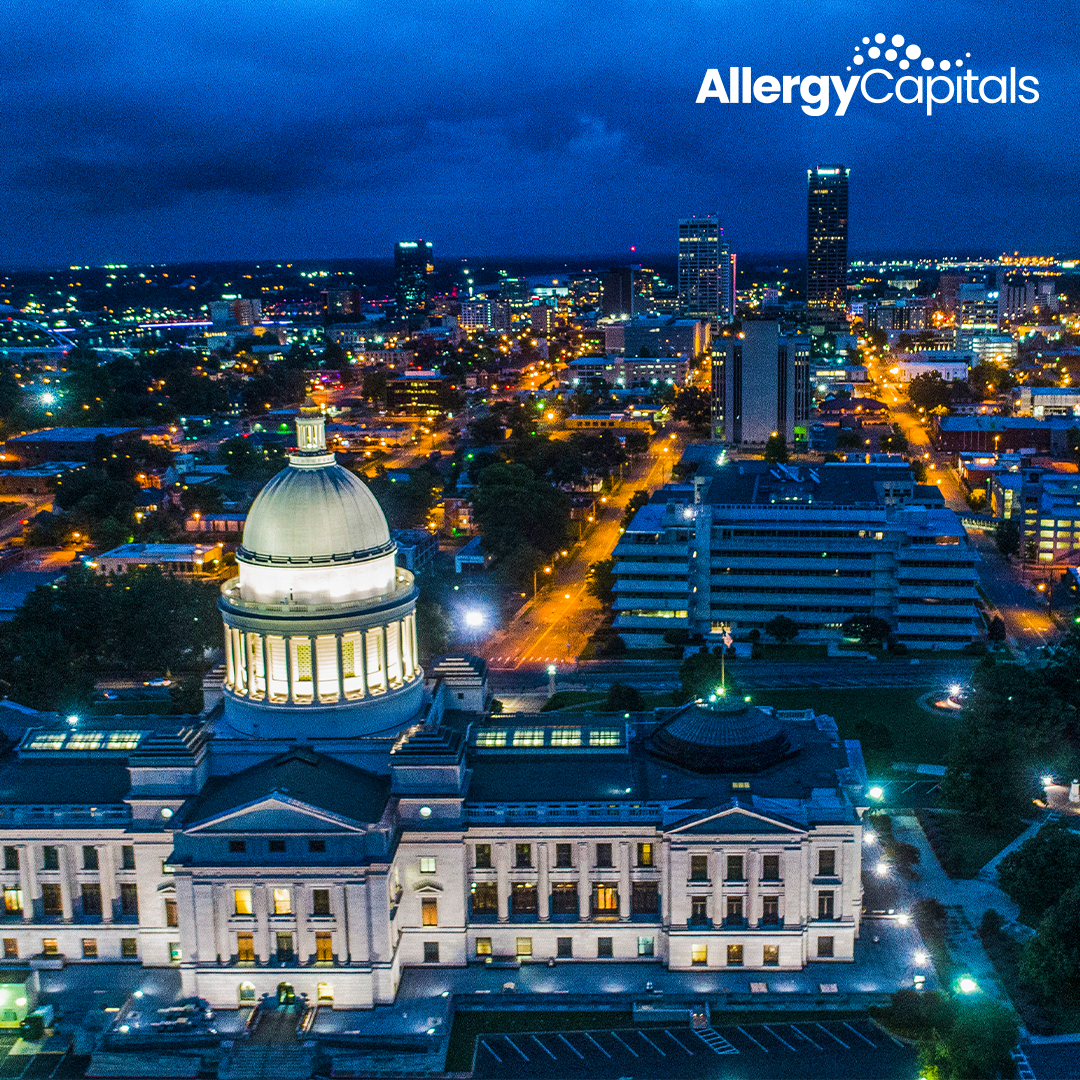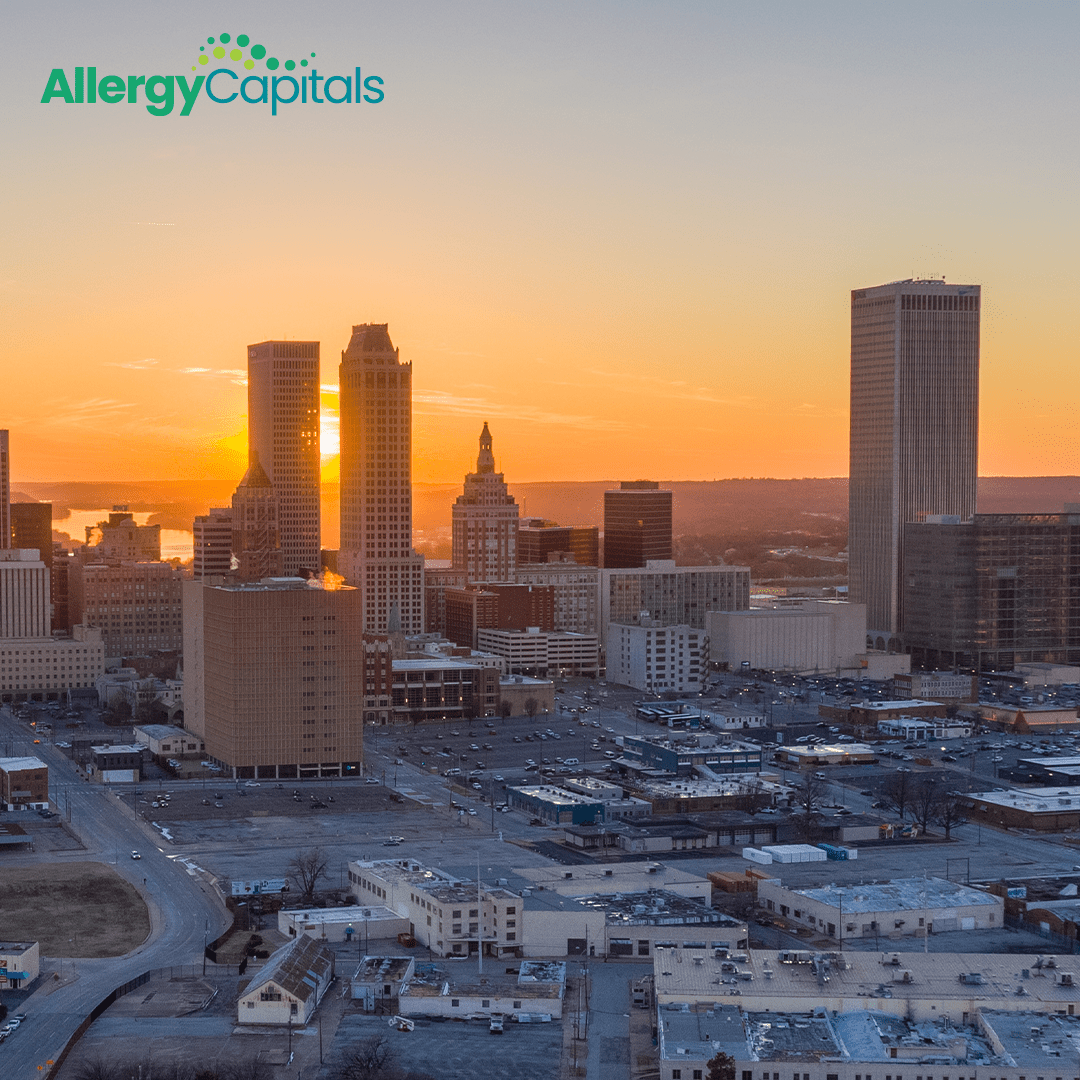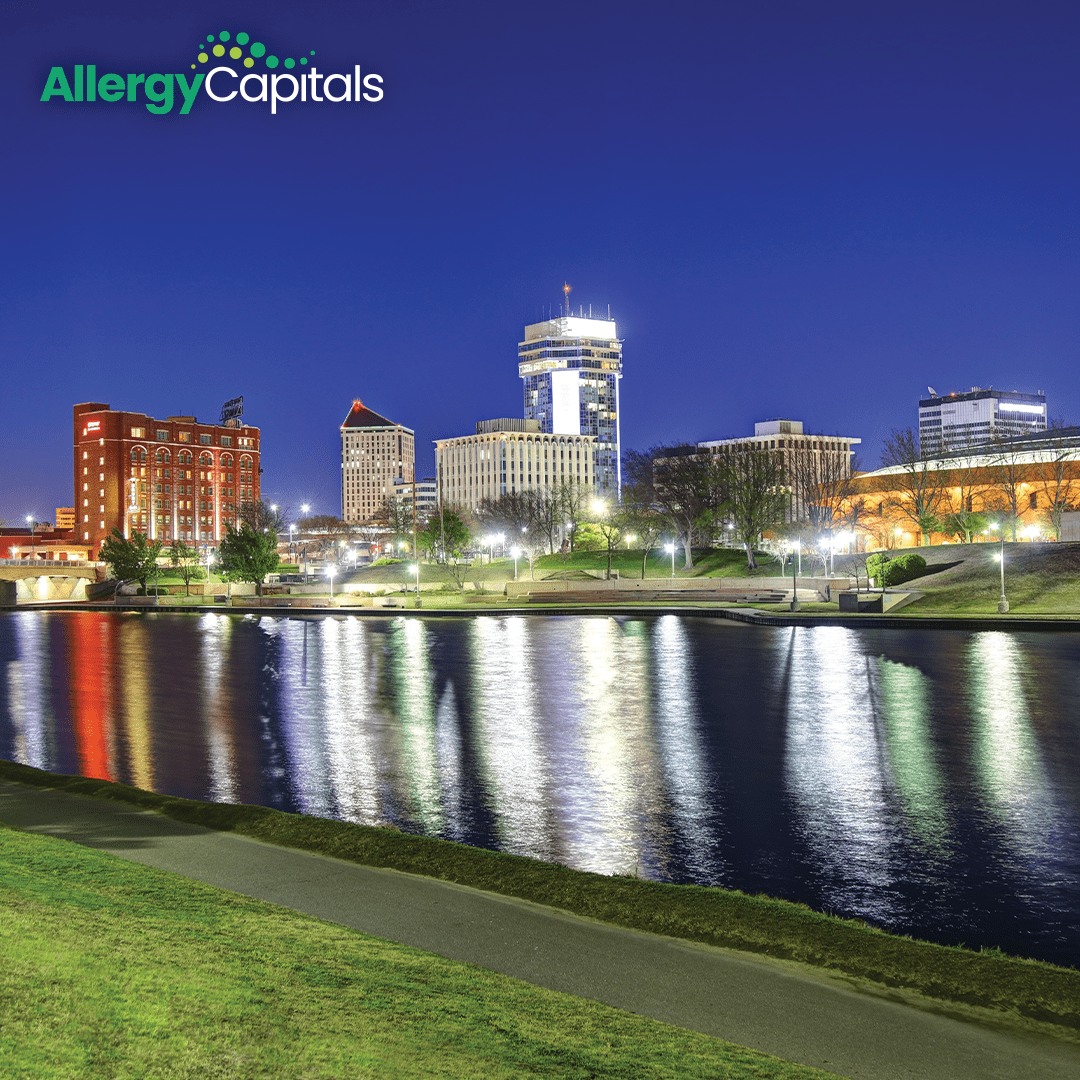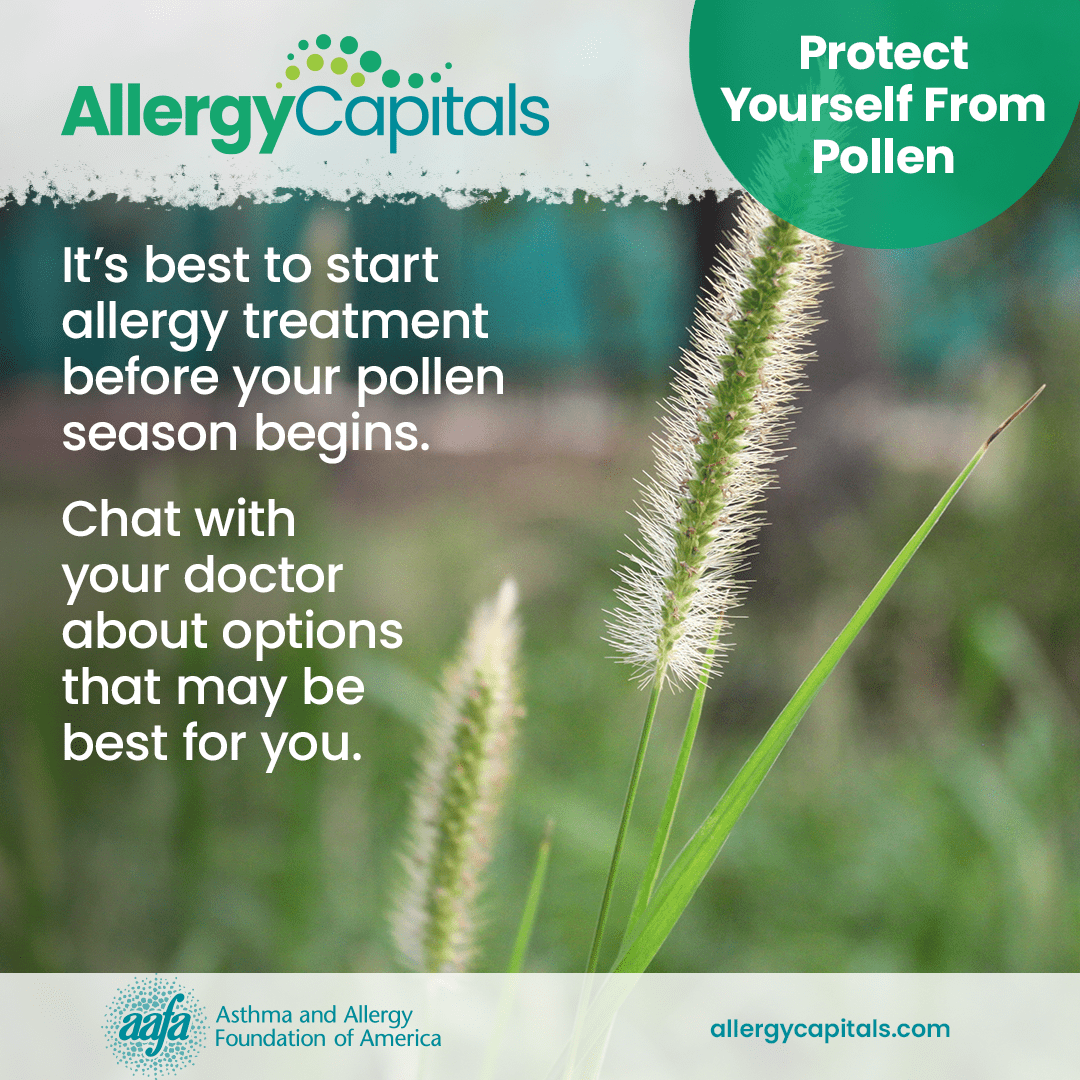Research and Reports
Allergy Capitals
The top 10 most challenging places to live with seasonal allergies are:
- Wichita, Kansas
- New Orleans, Louisiana
- Oklahoma City, Oklahoma
- Tulsa, Oklahoma
- Memphis, Tennessee
- Little Rock, Arkansas
- Raleigh, North Carolina
- Richmond, Virginia
- Greenville, South Carolina
- Greensboro, North Carolina
*AAFA studied data from the 100 most-populated U.S. metropolitan areas.
The report looks at these important factors:
- Tree, grass, and weed pollen scores throughout the year
- Over-the-counter allergy medicine use
- Availability of board-certified allergists/immunologists
This year’s report named Wichita, Kansas, as the top 2025 Allergy Capital for the third year in a row due to its:
- Worse-than-average tree and grass pollen
- Worse-than-average allergy medicine use
- Worse-than-average number of board-certified allergists/immunologists
Report Highlights
This year’s report focuses on these topics related to seasonal allergies:
- Types of pollen
- Allergic rhinitis and allergic asthma
- Managing your pollen allergies
- Climate change and urban areas
- Pollen counting
Tree, Grass, and Weed Pollen
Most of the pollen that causes allergic reactions comes from trees, grass, and weeds.
Tree pollen is the first pollen to appear each year in the U.S. Trees produce the most pollen from February through April. And in some regions, such as the South, trees may produce pollen as early as December or January.3
Grass pollen causes most late spring and summer pollen allergy symptoms from April through early June.4
Then, depending on your location, weed pollen – especially ragweed pollen – can trigger symptoms starting in August and peaking in mid-September. Ragweed season may last 6 to 10 weeks until the first frost.5 Some parts of the U.S. now have pollen year-round.
Allergic Rhinitis and Allergic Asthma
Pollen can cause symptoms for people with two common allergic conditions: seasonal allergic rhinitis (“hay fever” or “nasal allergies”) and allergic asthma.
Common symptoms of allergic rhinitis caused by seasonal allergies include:
- Runny nose (also known as rhinorrhea – usually a thin, clear discharge)
- Stuffy nose (due to blockage or nasal congestion)
- Sneezing
- Red and watery eyes
- Itchy nose, eyes, ears, or mouth
- Swelling around the eyes
Many people with asthma also have allergies. And allergies can trigger or worsen asthma. This is called allergic asthma. Common signs and symptoms of allergic asthma include:
- Shortness of breath
- Cough
- Chest tightness or pain
- Wheeze (a whistling sound when you breathe)
- Waking at night due to asthma symptoms
- A drop in lung function
Managing Your Pollen Allergies
Managing your seasonal allergies can help you keep your allergic rhinitis and allergic asthma well-controlled. Now more than ever there are a number of available and accessible options to help you find relief.
Work with your doctor to include the steps below in your allergy treatment plan:
- Prevent pollen from getting into your eyes, nose, mouth, and lungs
- Manage your contact with pollen
- Use allergy medicines and treatments to control your symptoms
- Rinse out your nose with a saline solution
- Ask your doctor about immunotherapy
Read the report to find more tips on how to manage your pollen allergies, no matter where you live.
Allergy Medicine Guide
Nasal rinse: Using a saline (saltwater) nose rinse can help cut down mucus and rinse allergens out of your nose. Remember to use these as directed.
Corticosteroid nasal sprays reduce inflammation (swelling) in the nose and block allergic reactions. They are the most effective medicine type for allergic rhinitis because they can reduce all symptoms, including nasal congestion. They can also provide some relief for eye allergy symptoms. Nasal corticosteroids have few side effects (e.g., headache, nose bleeds or irritation).
Corticosteroid nasal sprays: FLONASE®, Nasacort®, Nasonex™, Nasalide/Flunisolide, Omnaris™, QNASL®, RHINOCORT®
Antihistamines relieve sneezing and itching in the nose and eyes. They also reduce a runny nose and, to a lesser extent, nasal stuffiness. Look for a long-acting, non-drowsy antihistamine. The newer medicines do not carry the risk of toxicity and death that has been associated with older antihistamines like diphenhydramine.
Non-steroidal antihistamine nasal sprays (may cause drowsiness): Astelin®, Astepro®, Patanase®
Non-drowsy oral antihistamines: Allegra®, CLARINEX®, Claritin®
Oral antihistamines that may cause drowsiness in some individuals: Xyzal®, ZYRTEC®
Cetirizine (ZYRTEC®) and loratadine (Claritin®) are the antihistamines of choice for use during pregnancy. They have established safety profiles and are effective in treating allergy symptoms during pregnancy.
Diphenhydramine and related short-acting antihistamines (like promethazine) should be avoided. Diphenhydramine (known under the brand name BENADRYL®) is not a good choice to take for allergy symptoms because of its short-term action to manage symptoms and several known negative side effects. The major side effects of diphenhydramine and older generation antihistamines include drowsiness, sedation, dry mouth/eyes, and fatigue. This can also impair alertness, concentration, multitasking, and memory. In turn, this antihistamine can affect important functions, such as learning and test performance in children, as well as operation of machinery and cars in adults. As these medicines can impair you, they can affect work performance and safety.
Eye drops: Allergy eye drops can relieve eye burning, itchiness, redness, increased tearing, and swelling.
Antihistamine eye drops: Azelastine/Optivar, Bepreve®, Elestat®, LASTACAFT®, Opcon-A®, Systane® ZADITOR®, Patanol™, and Pataday®
Decongestants help shrink the lining of the nasal passages and relieve nasal stuffiness. They generally are only used for a short time (3 days). Read the instructions carefully and do not use them for extended amounts of time. Extended use of decongestant nasal sprays can cause a rebound effect that worsens your congestion. Make sure you talk with your doctor about the appropriate use of decongestants, limitations, and potential side effects.
Nasal spray decongestants: Afrin®, Vicks Sinex™
Oral decongestants: SUDAFED®
Some allergy medicines combine an antihistamine with a decongestant. Certain types of combo medicines (such as the ones that contain pseudoephedrine as the decongestant) are available “behind the counter”. Behind-the-counter products are available without a prescription but have limitations on purchases due to state and federal laws. Talking with pharmacy staff is generally necessary to obtain these types of allergy medications.
Decongestant + antihistamine combos: Allegra-D®, Claritin-D®, Clarinex-D, ZYRTEC-D®
Check with your doctor before using decongestants if you have high blood pressure, heart disease, glaucoma, thyroid disease, or trouble urinating. They may cause issues if you have any of these conditions and they may interact with other prescription medicines.
Federal Regulations on Decongestants
The oral form of phenylephrine (PE) is a common active ingredient in many OTC decongestants. An expert panel of the FDA reviewed studies which showed oral PE is not effective at relieving nasal congestion in commonly used doses. The FDA is proposing to end use of oral PE. This would remove these products from the U.S. market. The change would not affect the nasal spray forms of PE.
Decongestants that contain pseudoephedrine (PSE) require photo identification and are only available to purchase behind the pharmacy counter.
Cromolyn sodium is a nasal spray that blocks your body from releasing chemicals (such as histamine and leukotrienes) that cause allergy symptomsincluding histamine and leukotrienes. This medicine has few side effects, but you must take it three to six times a day. For optimal results, this medication should be used daily during your allergy season. It can be started up to one week before your allergy season begins.
Cromolyn sodium nasal spray: NasalCrom®
Leukotriene receptor antagonists (or modifiers) block the action of important chemical messengers (other than histamine) that are involved in allergic reactions. These medicines help manage asthma and allergic rhinitis symptoms. These medications are taken orally. How often you take them depends on the specific drug. Discuss the appropriate use of these medications with your doctor, including the risks and benefits of therapy.
Options include: ACCOLATE®, SINGULAIR®*, Zyflo CR®
*Note: Montelukast (brand name SINGULAIR®) has a black box warning because it can cause serious mental health side effects. This is a safety warning from the Food and Drug Administration (FDA). This means you need to be aware of a drug’s side effects or important instructions for safe use of the drug. We encourage you to speak with your health care provider before, during, and after the start of any new medicine. If your doctor recommends montelukast, talk with them about possible risks and concerns.
Medical Review: March 2025 by John James, MD
Climate Change and Urban Areas
Climate change is leading to longer and more intense allergy seasons.6,7,8 Warmer temperatures mean plants start growing sooner and they produce more highly allergenic pollen. Allergenicity means the strength of the allergic response to pollen. More exposure to pollen can trigger asthma and other allergic responses.
Even though trees are a source of pollen, they also help regulate climate. Trees remove CO2 from the atmosphere and store it. The shade from trees helps reduce surface temperature, and forests reduce flooding.
Urban areas with fewer trees have higher temperatures due to more surfaces that trap heat at ground-level, like buildings and roads. When a city area is warmer than a rural area due to these heat-absorbing surfaces, this is called an “urban heat island.” Read the report to learn more about the effects of climate change on pollen production, and what can be done to slow it down.
Pollen Counting
Pollen reports are valuable tools in helping you manage your seasonal allergies. But not all reports are equal. Some reports are pollen counts and some are pollen forecasts. While pollen forecasts can be helpful, pollen counts are more accurate.
Pollen sensors play an important role in gathering accurate pollen counts to help diagnose and treat allergies, study the impact of climate change, and produce crop forecasts.9,10 The 2025 Allergy Capitals report looks at the importance of pollen counts and possible solutions to improve pollen monitoring by using automated pollen sensors.
Frequently Asked Questions about Allergy Capitals
What Does It Mean If I Live in an Allergy Capital Lower on the List?
You may still be greatly affected by seasonal allergies. On one or more of the ranked factors, your city may be doing better compared to other cities. For example, your city may have more allergists available compared to other cities.
What Does It Mean If My City Isn’t Listed on the Report?
AAFA’s Allergy Capitals report ranks the top 100 populated metro areas in the United States. If your hometown is near a major city, your area may be included in the metro area of the major city. For example, the Seattle metropolitan area includes Tacoma, Bellevue, Everett, and all cities and suburbs in the surrounding area.
If your city’s population is lower than the population of the 100th most populated city, then your city will not be ranked. You may be greatly affected by seasonal allergies, but your town is not reflected in the report.
How Can I Get Relief from Seasonal Allergies?
No matter where you live, it’s hard to escape pollen. But you can manage your pollen allergy.
There are a number of available and accessible options to help you find relief. Work with your doctor to include the steps below in your allergy treatment plan:
- Manage your contact with pollen
- Use allergy medicines and treatments
- Rinse out your nose
- Ask your doctor about immunotherapy
Learn more about managing pollen allergies.
Acknowledgement
The 2025 Allergy Capitals report is an independent research project of the Asthma and Allergy Foundation of America and made possible by support from Opella.
AAFA thanks Pollen Sense, Komodo Health, and Circana for their support with data and report content.
The views and opinions expressed in this report are those of the AAFA authors and do not necessarily reflect the policies or positions of other individuals, sponsors, organizations, or companies.
Recommended Citation
Asthma and Allergy Foundation of America, (2025). 2025 Allergy Capitals. Retrieved from allergycapitals.com.
Media Inquiries
For media and related inquiries, contact gro.afaa@aidem.
Closed
References
- Ng, A.E. & Boersma, P. (2023). NCHS Data Brief, no 460: Diagnosed allergic conditions in adults: United States, 2021. National Center for Health Statistics. https://dx.doi.org/10.15620/cdc:122809
- Zablotsky, B., Black, L.I., & Akinbami, L.J. (2023). NCHS Data Brief, no 459: Diagnosed allergic conditions in children aged 0-17 years: United States, 2021. National Center for Health Statistics. https://dx.doi.org/10.15620/cdc:123250
- Lo, F., Bitz, C.M., Battisti, D.S., & Hess, J.J. (2019). Pollen calendars and maps of allergenic pollen in North America. Aerobiologia, 35(4), 613–633. https://doi.org/10.1007/s10453-019-09601-2
- American Academy of Allergy, Asthma & Immunology. (2023). Mowing Down Your Grass Allergies. Retrieved March 4, 2025, from https://www.aaaai.org/tools-for-the-public/conditions-library/allergies/mowing-down-your-grass-allergies
- American Academy of Allergy, Asthma & Immunology. (2020). Ragweed plants packed with pollen. Retrieved March 4, 2025, from https://www.aaaai.org/tools-for-the-public/conditions-library/allergies/ragweed
- Singh, A. B., & Kumar, P. (2022). Climate change and allergic diseases: An overview. Frontiers in Allergy, 3, 964987. https://doi.org/10.3389/falgy.2022.964987
- Poole, J. A., Barnes, C. S., Demain, J. G., Bernstein, J.A., Padukudru, M. A., Sheehan, W. J., Fogelbach, G. G., Wedner, J., Codina, R., Levetin, E., Cohn, J. R., Kagen, S., Portnoy, J. M., & Nel, A. E. (2019). Impact of weather and climate change with indoor and outdoor air quality in asthma: A work group report of the AAAAI Environmental Exposure and Respiratory Health Committee. Journal of Allergy and Clinical Immunology, 143(5), 1702–1710. https://doi.org/10.1016/j.jaci.2019.02.018
- Ziska, L. H., Makra, L., Harry, S. K., Bruffaerts, N., Hendrickx, M., Coates, F., Saarto, A., Thibaudon, M., Oliver, G., Damialis, A., Charalampopoulos, A., Vokou, D., Heidmarsson, S., Gudjohnsen, E., Bonini, M., Oh, J.-W., Sullivan, K., Ford, L., Brooks, G. D., & Myszkowska, D. (2019). Temperature-related changes in airborne allergenic pollen abundance and seasonality across the northern hemisphere: A retrospective data analysis. The Lancet Planetary Health, 3(3), e124–e131. https://doi.org/10.1016/S2542-5196(19)30015-4
- Maya-Manzano, J. M., Tummon, F., Abt, R., Allan, N., Bunderson, L., Clot, B., Crouzy, B., Daunys, G., Erb, S., Gonzalez-Alonso, M., Graf, E., Grewling, Ł., Haus, J., Kadantsev, E., Kawashima, S., Martinez-Bracero, M., Matavulj, P., Mills, S., Niederberger, E., & Lieberherr, G. (2023). Towards European automatic bioaerosol monitoring: Comparison of 9 automatic pollen observational instruments with classic Hirst-type traps. Science of the Total Environment, 866, 161220. https://doi.org/10.1016/j.scitotenv.2022.161220
- Buters, J., Clot, B., Galán, C., Gehrig, R., Gilge, S., Hentges, F., O’Connor, D., Sikoparija, B., Skjoth, C., Tummon, F., Adams-Groom, B., Antunes, C. M., Bruffaerts, N., Çelenk, S., Crouzy, B., Guillaud, G., Hajkova, L., Seliger, A. K., Oliver, G., & Ribeiro, H. (2022). Automatic detection of airborne pollen: an overview. Aerobiologia, 40. https://doi.org/10.1007/s10453-022-09750-x
.
Using Certified Asthma & Allergy Friendly® products in your home can help you have a healthier indoor environment, as well as reduce allergens.
To learn more about the Asthma & Allergy Friendly® Certification Program, visit: aafa.org/certified





